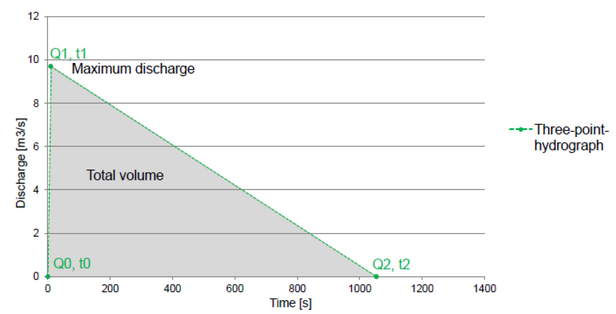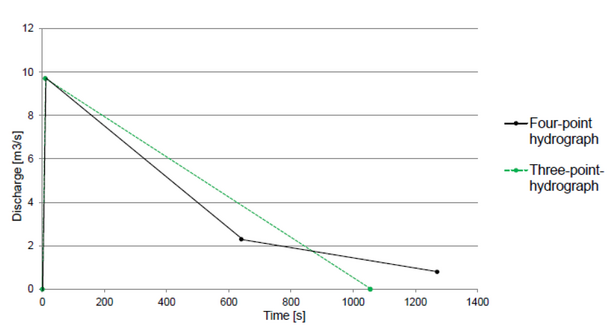In RAMMS::DEBRISFLOW there are two options to define the starting conditions (release information) of a simulation:
- Release area (or block release)
- Input hydrograph (or simply hydrograph)
The starting conditions of a simulation can be selected depending on the type of debris flow you want to model. Generally, it is useful to distinguish between unchannelized and channelized debris flows. Here we use the term unchannelized debris flow for hillslope debris flows or shallow landslides, channelized debris flows develop in regions where torrents limit the flow paths and the debris material mainly follows the torrent channel.
For small unchannelized debris flows it is useful to use a release area with a given initial depth, which will be released as a block (block release), while for a channelized debris flow it may be more appropriate to use an input hydrograph. The later requires knowledge of the amount of material that might flow past a certain location in the channel. Chapter 5on page 72 includes several examples for both types of starting conditions.
The definitions of release areas and release depths (block release) have a strong impact on the simulation results. The same applies for simulations with a hydrograph, where the results are sensitive to the discharge hydrograph. Therefore, we recommend to use reference information such as photography, GPS measurements or field maps to draw release areas and to use measured or well-estimated inflow data to define discharge hydrographs. This should be done by people with experience concerning the topographic and historical flow situation of the investigation area.
Input Hydrograph ¶
To simulate channelized debris flows it is advantageous to use an input hydrograph. However, this requires knowledge of the amount of material (discharge) that flows past at a given location. For a RAMMS simulation with a hydrograph you have two options. Either you know the discharge at different times at a given location, e.g. estimated by measured flow heights and corresponding channel cross sections, or you use the estimated total volume in combination with empirical relationships between total volume and maximum discharge (e.g. Rickenmann et al. 1999).
Field measurement of debris flow properties is beyond the scope of this handbook, however if debris flow activity in a catchment is frequent, it may be possible to obtain additional information for cali-brating RAMMS by installing a monitoring station. Many debris flows, when the monitoring data are simplified, have a relatively simple triangular wave-like shape (Figure 3.33). Assuming a well-estimated total volume (e.g. field data), maximum debris flow discharge ($Q$) and corresponding time ($t_1$), as well as the end time ($t_2$) can be calculated. We call this a three-point hydrograph calculation.

In nature, discharge hydrographs are generally better described by four points. However, a three-point hydrograph results in slightly larger flow heights and flow velocities after the maximum discharge. If the detailed discharge hydrograph is not known it is useful to choose a three-point hydrograph. In critical applications we encourage users to evaluate the sensitivity of the model results to the shape of the input hydrograph, e.g. when preparing different scenarios as a basis for hazard maps.

